Catch Efficiency of Multi-Mesh Trammel Nets for Sampling Freshwater Fishes
Abstract
:1. Introduction
2. Materials and Methods
2.1. Fishing Trials and Gear Specification
2.2. Catch Sampling
2.3. Data Analysis
E(CPUENij) = µij
Log(µij) = Soaktime + Locationi + Datej
Datei ~ N(0, σ2)
E(CPUESij) = µij
Log(µij) = Soaktime + Locationi + Datej
Datei ~ N(0, σ2)
E(CPUEWij) = µij
µij = Soaktime + Locationi + Datej
Datei ~ N(0, σ2)
3. Results
3.1. Catch Composition and Distribution
3.2. Dominant Species
3.3. Catch Per Unit Effort of the Multi-Mesh Trammel Net
3.3.1. CPUEN
3.3.2. CPUES
3.3.3. CPUEW
3.3.4. CPUEN for Shortjaw Tapertail Anchovy
4. Discussion
5. Conclusions
Author Contributions
Funding
Institutional Review Board Statement
Data Availability Statement
Acknowledgments
Conflicts of Interest
References
- Zhang, H.; Kang, M.; Shen, L.; Wu, J.; Li, J.; Du, H.; Wang, C.; Yang, H.; Zhou, Q.; Liu, Z.; et al. Rapid Change in Yangtze Fisheries and Its Implications for Global Freshwater Ecosystem Management. Fish Fish. 2020, 21, 601–620. [Google Scholar] [CrossRef]
- Jin, B.; Winemiller, K.O.; Ren, W.; Tickner, D.; Wei, X.; Guo, L.; Li, Q.; Zhang, H.; Pompeu, P.S.; Goichot, M.; et al. Basin-scale Approach Needed for Yangtze River Fisheries Restoration. Fish Fish. 2022, 23, 1009–1015. [Google Scholar] [CrossRef]
- Zhang, Y. Freshwater Biodiversity Conservation in China: Progress in the Yangtze River Basin. Aquat. Conserv. 2022, 32, 1565–1570. [Google Scholar] [CrossRef]
- Chen, T.; Wang, Y.; Gardner, C.; Wu, F. Threats and Protection Policies of the Aquatic Biodiversity in the Yangtze River. J. Nat. Conserv. 2020, 58, 125931. [Google Scholar] [CrossRef]
- Lynch, A.J.; Cooke, S.J.; Beard, T.D., Jr.; Kao, Y.-C.; Lorenzen, K.; Song, A.M.; Allen, M.S.; Basher, Z.; Bunnell, D.B.; Camp, E.V.; et al. Grand Challenges in the Management and Conservation of North American Inland Fishes and Fisheries. Fisheries 2017, 42, 115–124. [Google Scholar] [CrossRef]
- Casselman, J.M.; Penczak, T.; Carl, L.; Mann, R.H.; Holcik, J.; Woitowich, W.A. An evaluation of fish sampling methodologies for large river systems. Pol. Arch. Hydrobiol. 1990, 37, 521–551. [Google Scholar]
- Portt, C.B.; Coker, G.A.; Ming, D.L.; Randall, R.G. A review of fish sampling methods commonly used in Canadian freshwater habitats. Can. Tech. Rep. Fish. Aquat. Sci. 2006, 2604. Available online: https://publications.gc.ca/collections/collection_2012/mpo-dfo/Fs97-6-2604-eng.pdf (accessed on 8 February 2023).
- Radinger, J.; Britton, J.R.; Carlson, S.M.; Magurran, A.E.; Alcaraz-Hernández, J.D.; Almodóvar, A.; Benejam, L.; Fernández-Delgado, C.; Nicola, G.G.; Oliva-Paterna, F.J.; et al. Effective Monitoring of Freshwater Fish. Fish Fish. 2019, 20, 729–747. [Google Scholar] [CrossRef]
- Evans, N.T.; Lamberti, G.A. Freshwater Fisheries Assessment Using Environmental DNA: A Primer on the Method, Its Potential, and Shortcomings as a Conservation Tool. Fish. Res. 2018, 197, 60–66. [Google Scholar] [CrossRef]
- Kubečka, J.; Godø, O.R.; Hickley, P.; Prchalová, M.; Říha, M.; Rudstam, L.; Welcomme, R. Fish Sampling with Active Methods. Fish. Res. 2012, 123–124, 1–3. [Google Scholar] [CrossRef]
- Wanner, G.A.; Shuman, D.A.; Brown, M.L.; Willis, D.W. An Initial Assessment of Sampling Procedures for Juvenile Pallid Sturgeon in the Missouri River Downstream of Fort Randall Dam, South Dakota and Nebraska. J. Appl. Ichthyol. 2007, 23, 529–538. [Google Scholar] [CrossRef]
- Argent, D.G.; Kimmel, W.G. Efficiency and Selectivity of Gill Nets for Assessing Fish Community Composition of Large Rivers. N. Am. J. Fish. Manag. 2005, 25, 1315–1320. [Google Scholar] [CrossRef]
- He, P. Gillnets: Gear design, fishing performance and conservation challenges. Mar. Technol. Soc. J. 2006, 40, 12–19. [Google Scholar] [CrossRef]
- Gray, C.A.; Jones, M.V.; Rotherham, D.; Broadhurst, M.K.; Johnson, D.D.; Barnes, L.M. Utility and efficiency of multi-mesh gill nets and trammel nets for sampling assemblages and populations of estuarine fish. Mar. Freshw. Res. 2005, 56, 1077–1088. [Google Scholar] [CrossRef]
- Grimaldo, E.; Herrmann, B.; Su, B.; Føre, H.M.; Vollstad, J.; Olsen, L.; Larsen, R.B.; Tatone, I. Comparison of Fishing Efficiency between Biodegradable Gillnets and Conventional Nylon Gillnets. Fish. Res. 2019, 213, 67–74. [Google Scholar] [CrossRef]
- Lloyd, J.A.; Mounsey, R.P. The potential of the trammel net as an alternative method for sampling fish on deep water reefs. Fish. Res. 1998, 39, 67–74. [Google Scholar] [CrossRef]
- Rotherham, D.; Gray, C.A.; Broadhurst, M.K.; Johnson, D.D.; Barnes, L.M.; Jones, M.V. Sampling Estuarine Fish Using Multi-Mesh Gill Nets: Effects of Panel Length and Soak and Setting Times. J. Exp. Mar. Bio. Ecol. 2006, 331, 226–239. [Google Scholar] [CrossRef]
- Losanes, L.P.; Matuda, K.; Fujimori, Y. Outdoor Tank Experiments on the Influence of Soaking Time on the Catch Efficiency of Gillnets and Entangling Nets. Fish. Res. 1992, 15, 217–227. [Google Scholar] [CrossRef]
- Acosta, A.R. Soak Time and Net Length Effects on Catch Rate of Entangling Nets in Coral Reef Areas. Fish. Res. 1994, 19, 105–119. [Google Scholar] [CrossRef]
- Saber, M.A.; El-Ganainy, A.A.; Shaaban, A.M.; Osman, H.M.; Ahmed, A.S. Trammel Net Size Selectivity and Determination of a Minimum Legal Size (MLS) for the Haffara Seabream, Rhabdosargus Haffara in the Gulf of Suez. Egypt. J. Aquat. Res. 2022, 48, 137–142. [Google Scholar] [CrossRef]
- Beauchamp, D.A.; Parrish, D.L.; Whaley, R.A. Coldwater Fish in Large Standing Waters; Standard Methods for Sampling North American Freshwater Fishes; American Fisheries Society: Bethesda, MD, USA, 2009; pp. 97–117. [Google Scholar]
- Chen, D. The Handbook for Monitoring Acquatic Resources in the Yangtze River Basin; China Agriculture Press: Beijing, China, 2021; pp. 33–42. (In Chinese) [Google Scholar]
- Team, R.C. R: A Language and Environment for Statistical Computing. Available online: http://www.R-project.org (accessed on 8 February 2023).
- Harrison, X.A.; Donaldson, L.; Correa-Cano, M.E.; Evans, J.; Fisher, D.N.; Goodwin, C.E.D.; Robinson, B.S.; Hodgson, D.J.; Inger, R. A Brief Introduction to Mixed Effects Modelling and Multi-Model Inference in Ecology. PeerJ 2018, 6, e4794. [Google Scholar] [CrossRef]
- Hartig, F. DHARMa: Residual Diagnostics for Hierarchical (Multi-Level/Mixed) Regression Models [Online]. R Foundation for Statistical Computing, Vienna, Austria. Available online: https://cran.r-project.org/web/packages/DHARMa/vignettes/DHARMa.html (accessed on 8 February 2023).
- Bates, D.; Mächler, M.; Bolker, B.; Walker, S. Fitting Linear Mixed-Effects Models Using Lme4. J. Stat. Softw. 2015, 67, 1–48. [Google Scholar] [CrossRef]
- Nakagawa, S.; Schielzeth, H. A general and simple method for obtaining R2 from generalized linear mixed-effects models. Methods Ecol. Evol. 2012, 4, 133–142. [Google Scholar] [CrossRef]
- Barton, K. Mu-MIn: Multi-Model Inference. R Package Version 0.12. 2/r18. 2009. Available online: http://R-Forge.R-project.org/projects/mumin/ (accessed on 8 February 2023).
- He, P.; Pol, M. Fish behaviour near gillnets: Capture processes and influencing factors. In Behaviour of Marine Fishes; He, P., Ed.; Wiley-Blackwell: Ames, IA, USA, 2010; pp. 205–236. [Google Scholar]
- Regier, H.A.; Robson, D.S. Selectivity of gill nets, especially to lake whitefish. J. Fish. Res. Board Can. 1966, 23, 423–454. [Google Scholar] [CrossRef]
- Prchalová, M.; Mrkvička, T.; Peterka, J.; Čech, M.; Berec, L.; Kubečka, J. A Model of Gillnet Catch in Relation to the Catchable Biomass, Saturation, Soak Time and Sampling Period. Fish. Res. 2011, 107, 201–209. [Google Scholar] [CrossRef]
- Reis, E.G.; Pawson, M.G. Fish Morphology and Estimating Selectivity by Gillnets. Fish. Res. 1999, 39, 263–273. [Google Scholar] [CrossRef]
- Olin, M.; Kurkilahti, M.; Peitola, P.; Ruuhijärvi, J. The Effects of Fish Accumulation on the Catchability of Multimesh Gillnet. Fish. Res. 2004, 68, 135–147. [Google Scholar] [CrossRef]
- Yimer, M.A.; Cao, L.; Shen, J.-Z.; Zhang, E. Age, Growth, Maturity and Mortality of the Tapetail Anchovy Coilia Brachygnathus (Engraulidae) in Lake Honghu, China. J. Fish Biol. 2023, 2, 1–12. [Google Scholar] [CrossRef]
- Fang, D.; Yang, H.; Zhang, H.; Wu, J.; Wei, Q. Fish community structure and diversity in the middle reaches of the Yangtze River. Shuichan Xuebao 2023, 47, 154–170. (In Chinese) [Google Scholar]
- Butler, S.E.; Freedman, J.A.; Diana, M.J.; Wahl, D.H. Evaluation of gears for sampling different life stages of asian carp. (presentation). In Proceedings of the 143rd Annual Meeting of the American Fisheries Society, Little Rock, AR, USA, 8–14 September 2013. [Google Scholar]
- Harley, S.J.; Myers, R.A.; Dunn, A. Is Catch-per-Unit-Effort Proportional to Abundance? Can. J. Fish. Aquat. Sci. 2001, 58, 1760–1772. [Google Scholar] [CrossRef]
- Olin, M.; Tiainen, J.; Kurkilahti, M.; Rask, M.; Lehtonen, H. An Evaluation of Gillnet CPUE as an Index of Perch Density in Small Forest Lakes. Fish. Res. 2016, 173, 20–25. [Google Scholar] [CrossRef]
- Savina, E.; Krag, L.A.; Frandsen, R.P.; Madsen, N. Effect of Fisher’s Soak Tactic on Catch Pattern in the Danish Gillnet Plaice Fishery. Fish. Res. 2017, 196, 56–65. [Google Scholar] [CrossRef]
- Plumlee, J.D.; Roskar, G.; Craig, J.K.; Fodrie, F.J. Assessing the Catch Efficiency of Predators in the Presence of Prey Using Experimental Gillnets in a Temperate Estuary. Fish. Res. 2022, 253, 106383. [Google Scholar] [CrossRef]
- Stergiou, K.I.; Moutopoulos, D.K.; Soriguer, M.C.; Puente, E.; Lino, P.G.; Zabala, C.; Monteiro, P.; Errazkin, L.A.; Erzini, K. Trammel net catch species composition, catch rates and métiers in Southern European waters: A Multivariate Approach. Fish. Res. 2006, 79, 170–182. [Google Scholar] [CrossRef]
- Borgstrøm, R.; Bergum, K.; Børresen, T.E.; Svenning, M.A. Gillnet Catchability of Brown Trout Salmo Trutta Is Highly Dependent on Fish Size and Capture Site. Fauna Norv. 2019, 39, 30–38. [Google Scholar] [CrossRef]
- Hamley, J.M. Review of Gillnet Selectivity. J. Fish. Res. Board Can. 1975, 32, 1943–1969. [Google Scholar] [CrossRef]
- Gray, C.A.; Broadhurst, M.K.; Johnson, D.D.; Young, D.J. Influences of Hanging Ratio, Fishing Height, Twine Diameter and Material of Bottom-Set Gillnets on Catches of Dusky Flathead Platycephalus Fuscus and Non-Target Species in New South Wales, Australia. Fish Sci. 2005, 71, 1217–1228. [Google Scholar] [CrossRef]
- Grimaldo, E.; Herrmann, B.; Jacques, N.; Vollstad, J.; Su, B. Effect of Mechanical Properties of Monofilament Twines on the Catch Efficiency of Biodegradable Gillnets. PLoS ONE 2020, 15, e0234224. [Google Scholar] [CrossRef]
- Wanner, G.A.; Klumb, R.A.; Shuman, D.A.; Steffensen, K.D.; Stukel, S.; Utrup, N.J. Comparison of Green and White Mesh Trammel Nets and Gill Nets to Assess the Fish Community in a Large River. N. Am. J. Fish. Manag. 2010, 30, 12–25. [Google Scholar] [CrossRef]
- Koike, A.; Matuda, K. Catching Efficiency of Trammel Net with Different Slacknesse and Mesh Sizes of Inner Net. Nippon Suisan Gakkai Shi 1988, 54, 221–227. [Google Scholar] [CrossRef]
- Acosta, A.R.; Appeldoorn, R.S. Catching Efficiency and Selectivity of Gillnets and Trammel Nets in Coral Reefs from Southwestern Puerto Rico. Fish Res. 1995, 22, 175–196. [Google Scholar] [CrossRef]
- Erzini, K.; Gonçalves, J.M.S.; Bentes, L.; Moutopoulos, D.K.; Casal, J.A.H.; Soriguer, M.C.; Puente, E.; Errazkin, L.A.; Stergiou, K.I. Size Selectivity of Trammel Nets in Southern European Small-Scale Fisheries. Fish Res. 2006, 79, 183–201. [Google Scholar] [CrossRef]
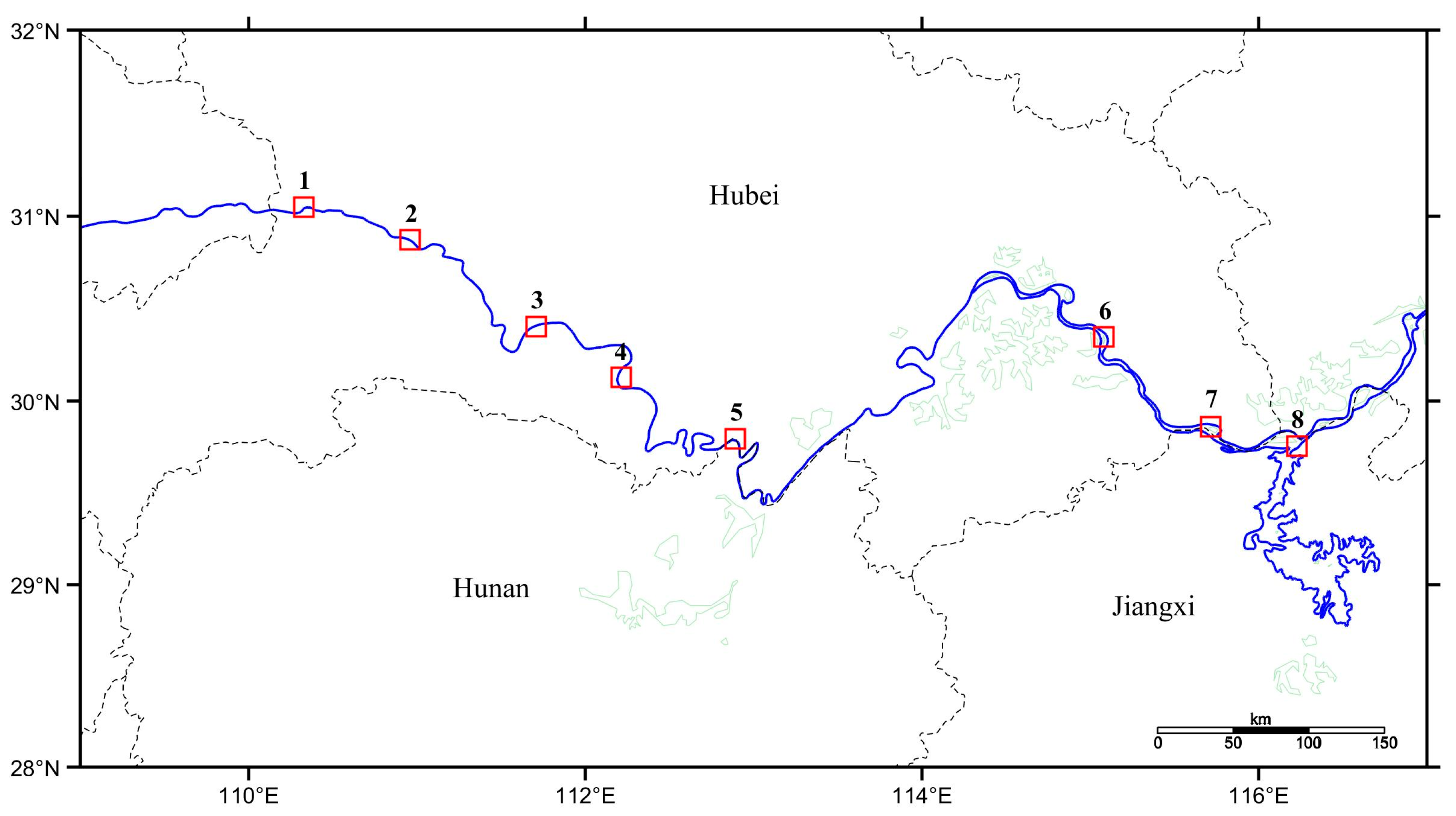
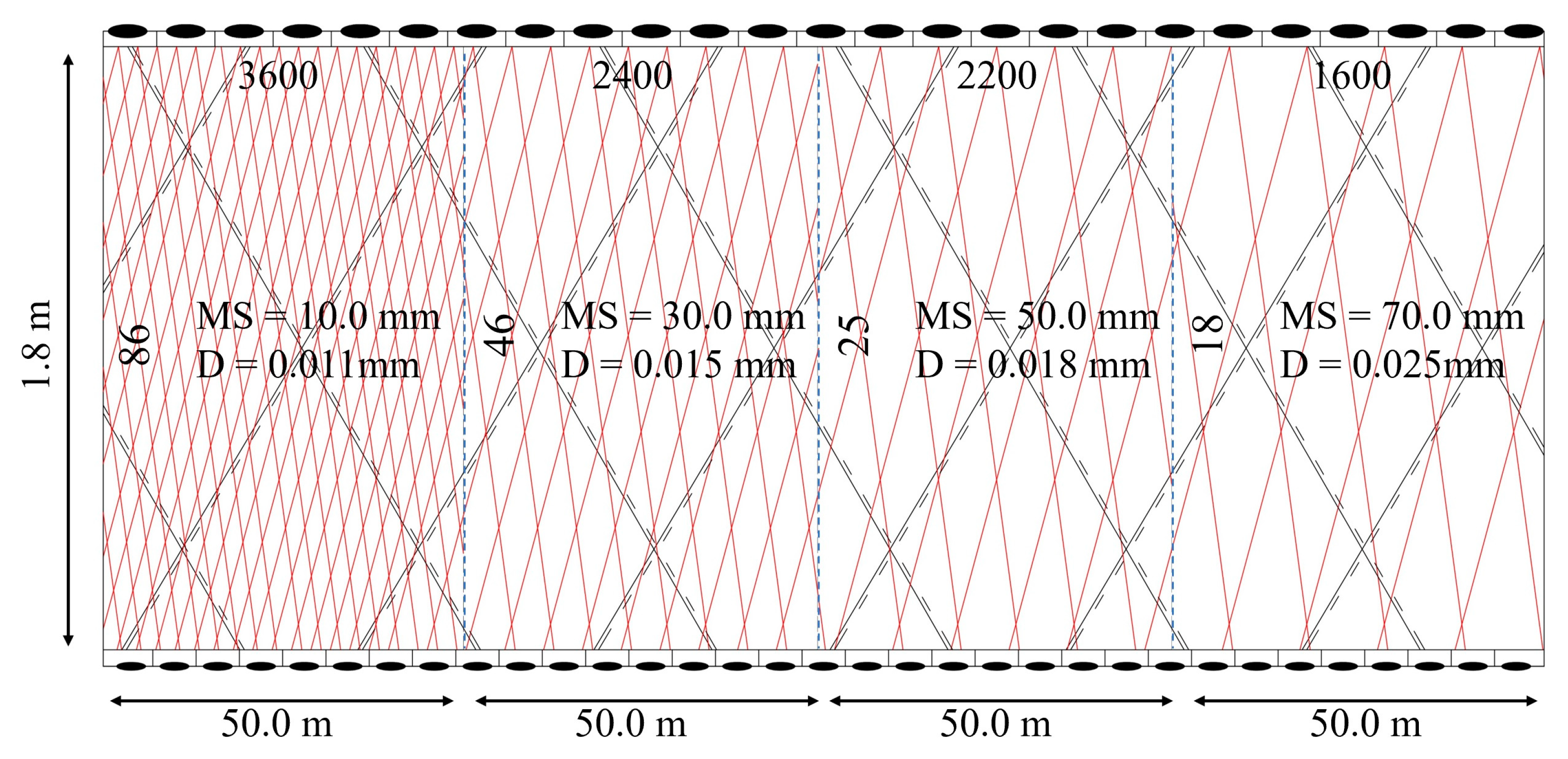
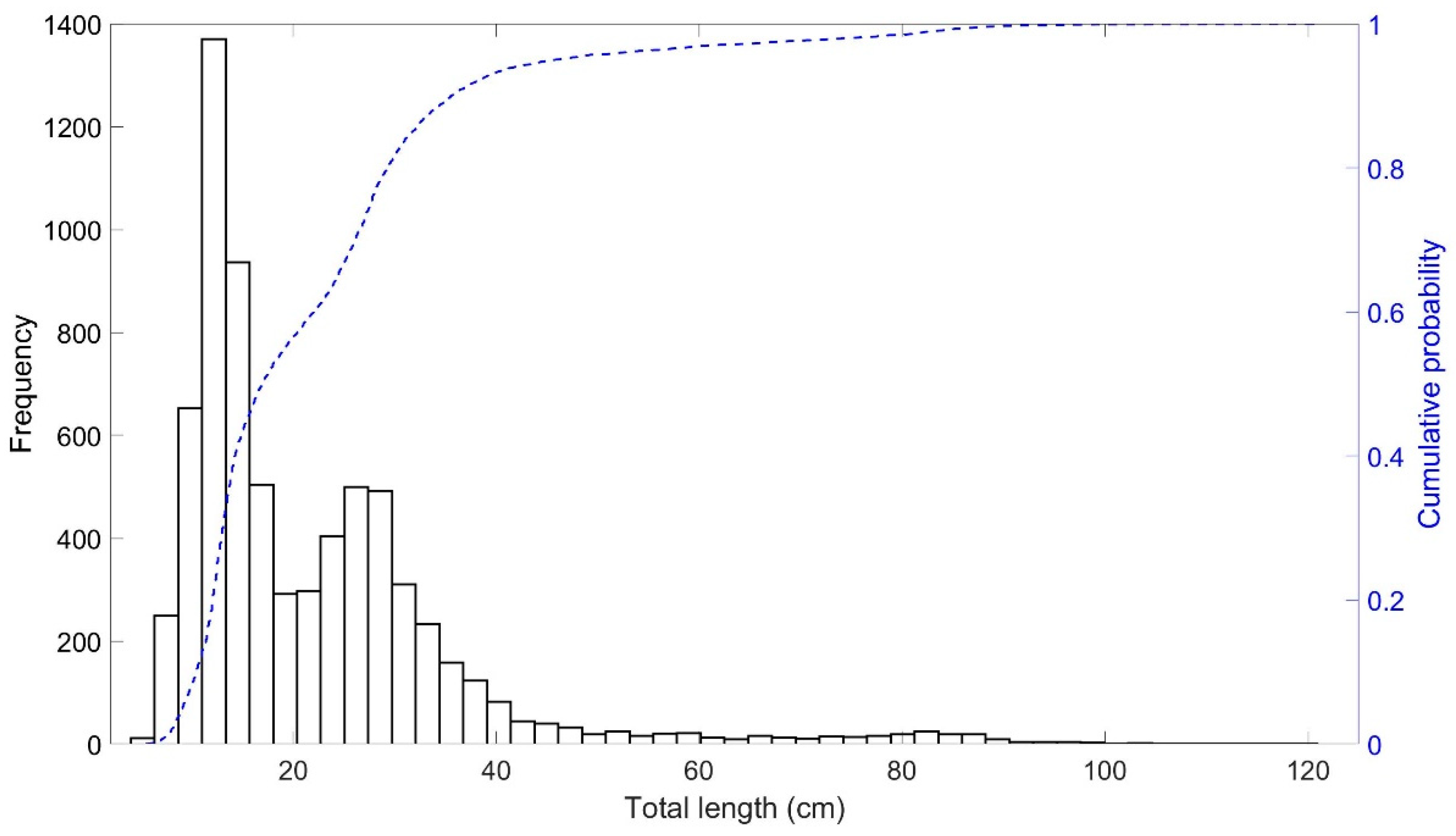
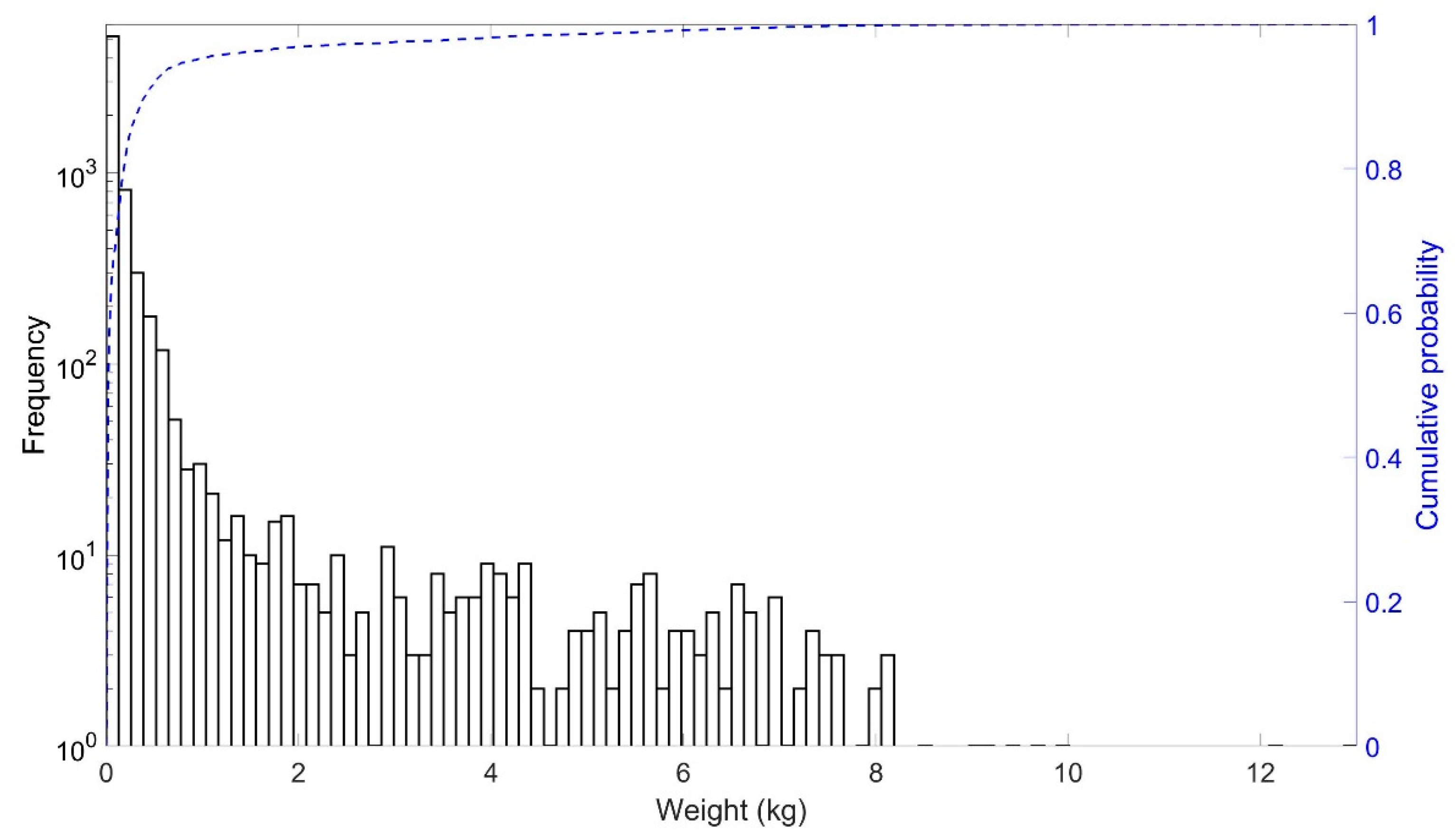
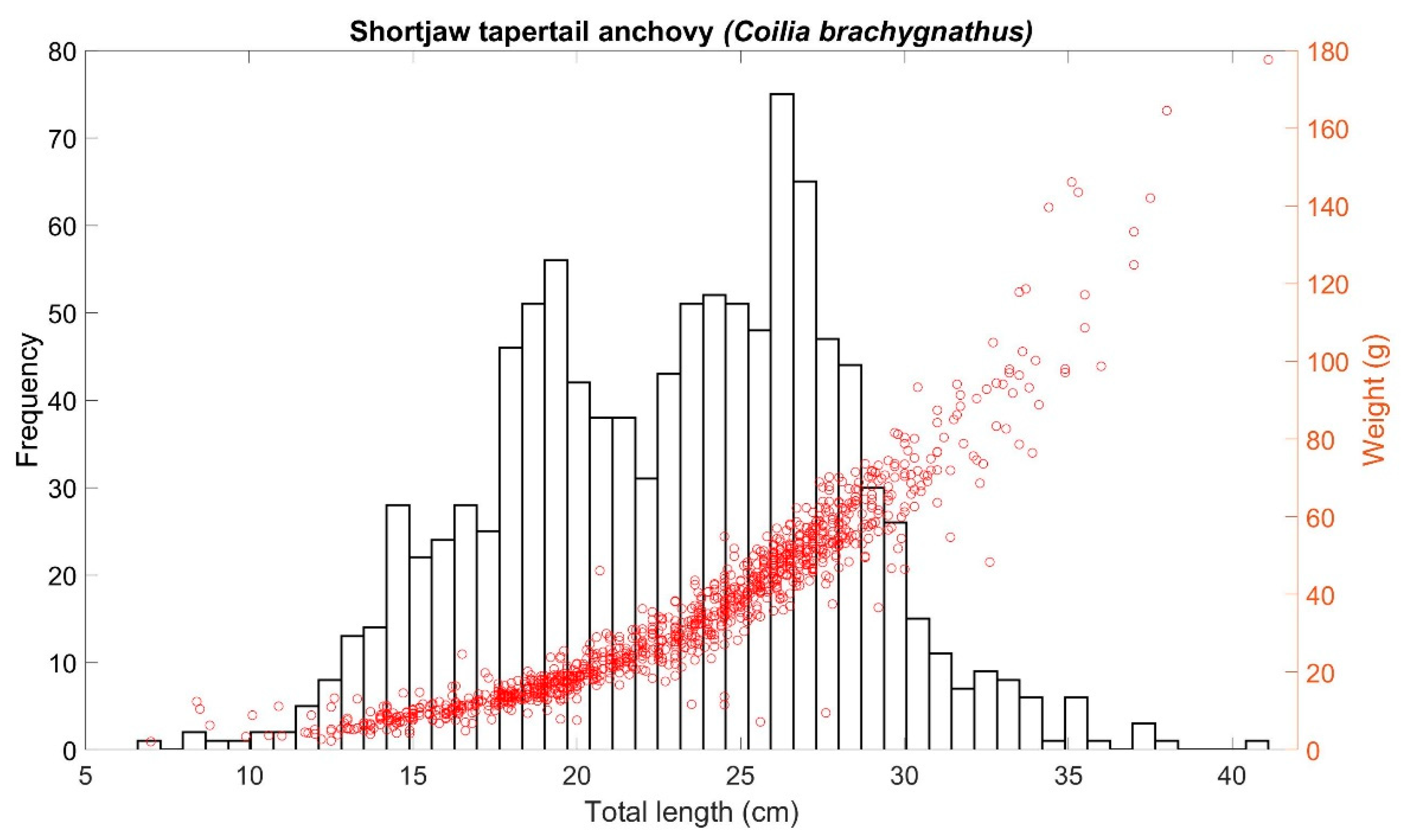

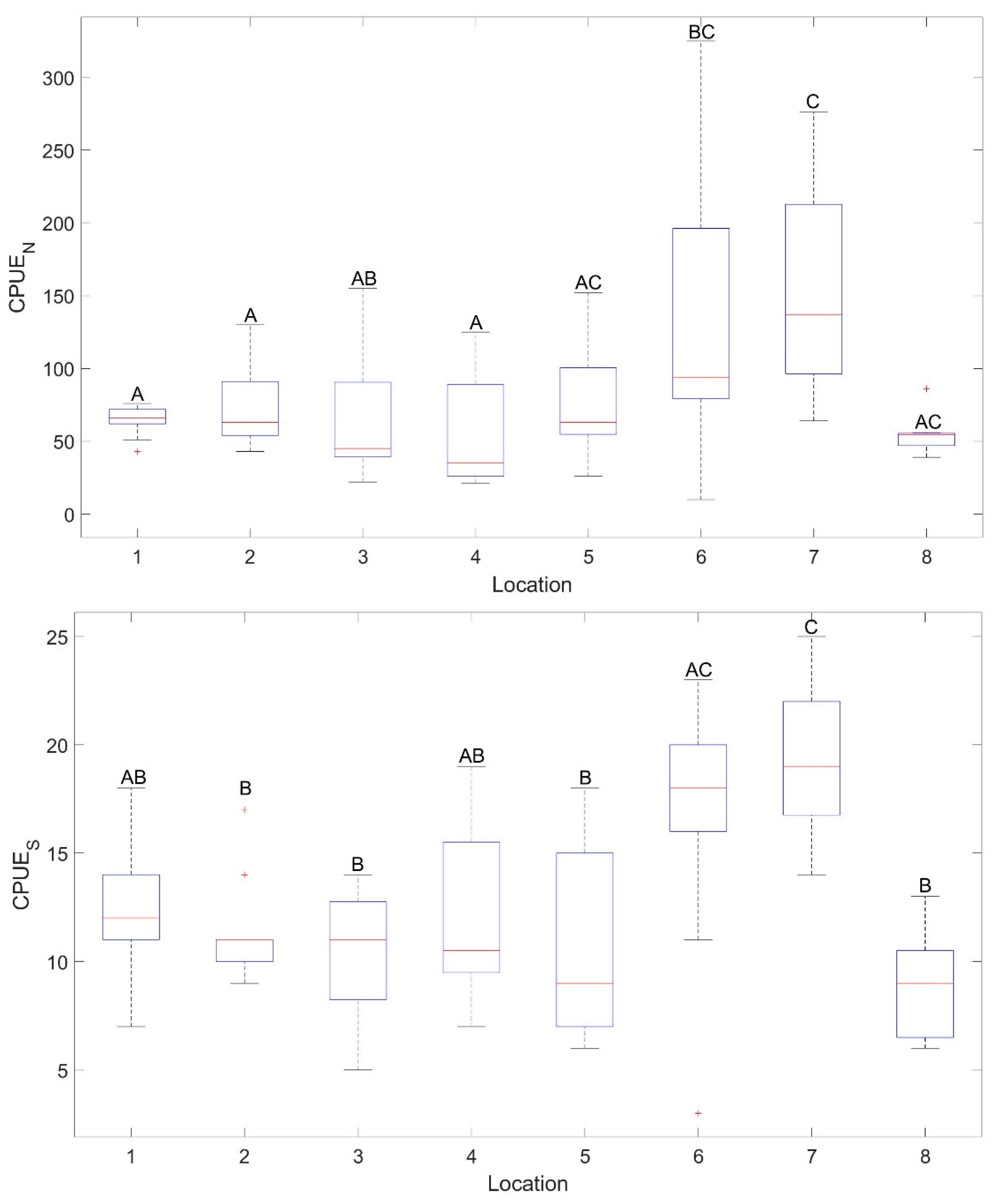
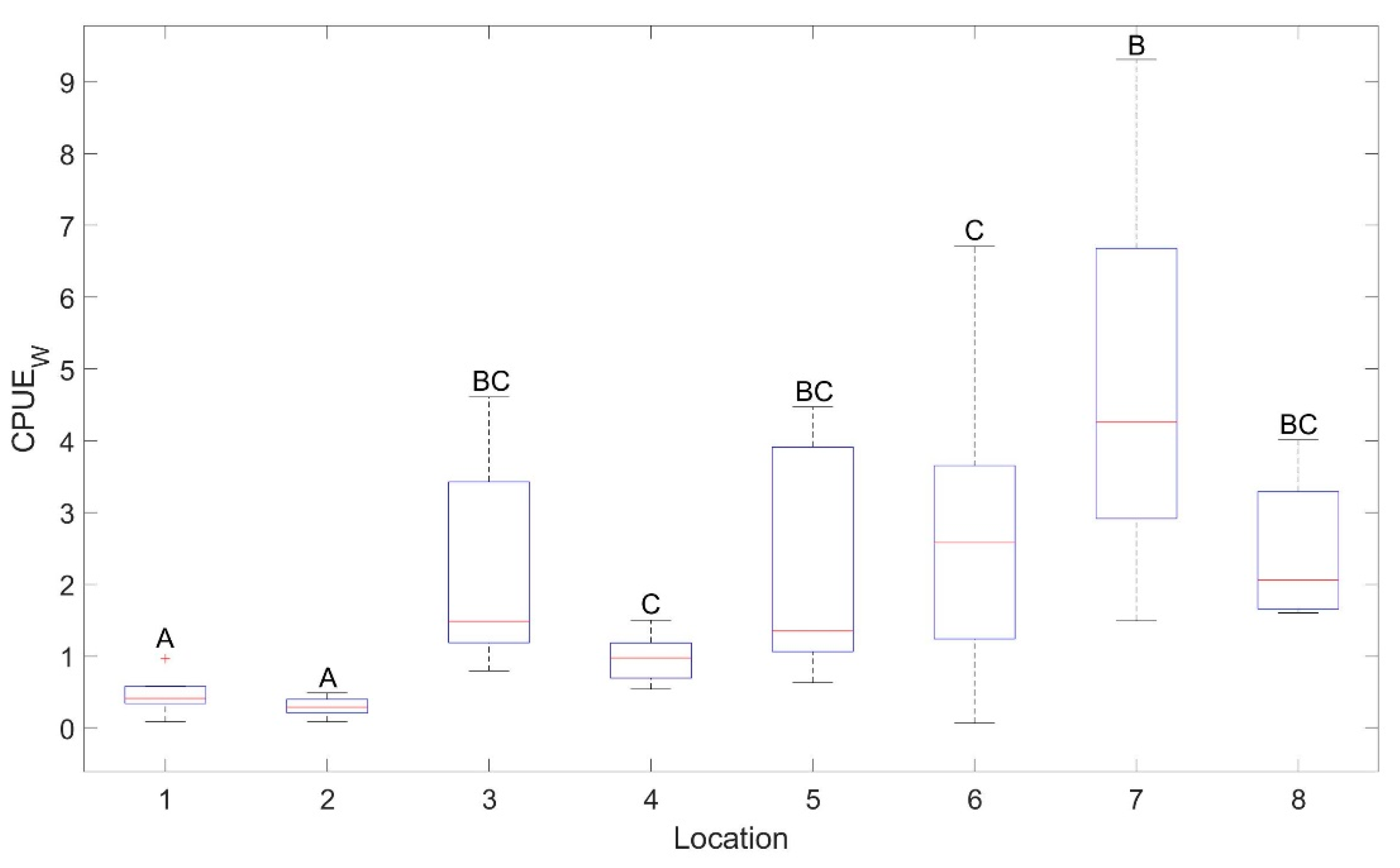
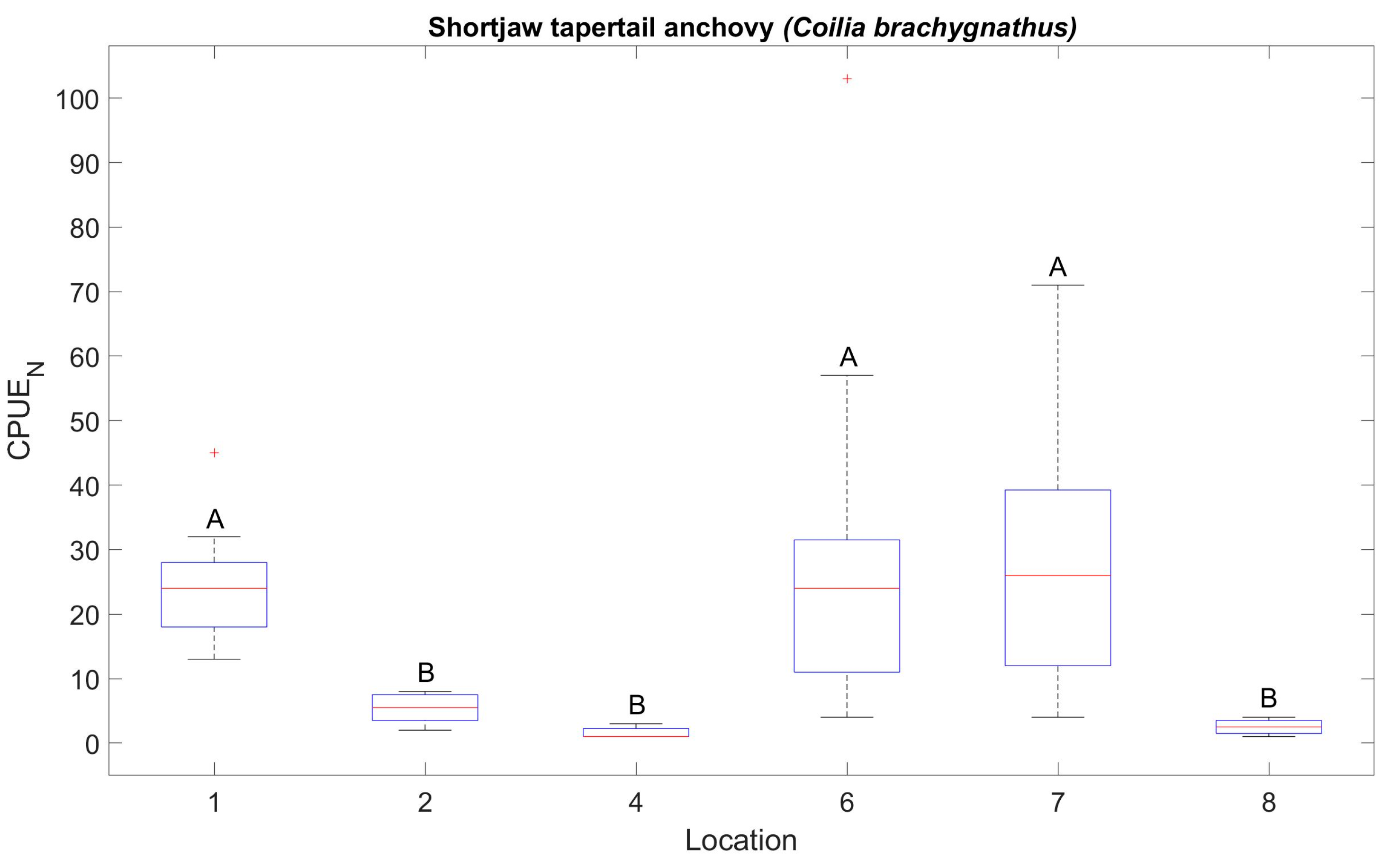
| Location | Deployment | Soak Time (h) (Min–Max) | Catch Number | Catch Weight (kg) |
|---|---|---|---|---|
| 1 | 10 | 11.6–12.0 | 637 | 45.67 |
| 2 | 10 | 12.0–13.0 | 744 | 29.50 |
| 3 | 7 | 15.5–19.3 | 471 | 158.57 |
| 4 | 8 | 16.6–19.5 | 407 | 62.94 |
| 5 | 9 | 17.5–24.0 | 711 | 195.98 |
| 6 | 17 | 10.6–22.1 | 2393 | 441.64 |
| 7 | 17 | 9.4–17.6 | 470 | 211.45 |
| 8 | 8 | 23.5–24.0 | 2536 | 784.82 |
| Species | Total Weight (kg) | Total Number |
|---|---|---|
| Coilia brachygnathus | 40.70 | 1208 |
| Parabramis spp. | 257.71 | 935 |
| Pelteobagrus vachelli | 80.67 | 789 |
| Hemiculter spp. | 10.09 | 696 |
| Culter spp. | 103.70 | 641 |
| Pelteobagrus nitidus | 9.62 | 616 |
| Xenocypris argentea | 64.59 | 615 |
| Pseudobrama simoni | 5.29 | 386 |
| Megalobrama spp. | 24.93 | 345 |
| Saurogobio spp. | 9.54 | 313 |
| Leiocassis spp. | 97.28 | 211 |
| Squalidus argentatus | 3.52 | 200 |
| Rhodeus spp. | 1.10 | 183 |
| Erythroculter mongolicus | 41.31 | 157 |
| Pelteobagrus fulvidraco | 8.53 | 135 |
| Hypophthalmichthys molitrix | 289.43 | 125 |
| Coilia macrognathos | 9.10 | 101 |
| Aristichthys nobilis | 565.22 | 99 |
| Siniperca kneri | 50.93 | 91 |
| Pseudolaubuca sp. | 1.73 | 84 |
| Carassius auratus | 20.07 | 80 |
| Coreius heterodon | 10.71 | 58 |
| Hemibagrus macropterus | 7.57 | 38 |
| Hemibarbus spp. | 4.89 | 32 |
| Cyprinus carpio | 54.46 | 28 |
| Elopichthys bambusa | 4.53 | 25 |
| Siniperca scherzeri | 6.86 | 22 |
| Pseudobagrus spp. | 0.70 | 21 |
| Rhinogobio spp. | 1.26 | 20 |
| Acipenser spp. | 85.48 | 19 |
| Pelteobagrus eupogon | 1.46 | 16 |
| Silurus meridionalis | 11.01 | 14 |
| Sander lucioperca | 0.35 | 11 |
| Silurus asotus | 7.39 | 11 |
| Ctenopharyngodon idellus | 19.36 | 7 |
| Chanodichthys erythropterus | 0.83 | 6 |
| Spinibarbus sinensis | 4.96 | 5 |
| Squaliobarbus curriculus | 1.88 | 5 |
| Myxocyprinus asiaticus | 4.42 | 4 |
| Parabotia fasciata | 0.12 | 4 |
| Ochetobius elongatus | 0.26 | 3 |
| Pelodiscus sinensis | 0.51 | 2 |
| Sarcocheilichthys sinensis | 0.11 | 2 |
| Channa argus | 0.23 | 1 |
| Cirrhinus molitorella | 0.46 | 1 |
| Cyprinus carpio specularis | 0.53 | 1 |
| Misgurnus anguillicaudatus | 0.0027 | 1 |
| Mylopharyngodon piceus | 4.25 | 1 |
| Neosalanx taihuensis | 0.0022 | 1 |
| Paracanthobrama guichenoti | 0.35 | 1 |
| Plagionatrops microlepris | 0.57 | 1 |
| Dependent Variable | Marginal Pseudo-R2 | Conditional Pseudo-R2 | Random Variable | Fixed Variable | Estimate | Std. Error | z/t Value | p-Value |
|---|---|---|---|---|---|---|---|---|
| CPUEN | 0.397 | 0.870 | Date | Intercept | 4.384 | 0.329 | 13.311 | <0.001 |
| Soaktime | −0.034 | 0.022 | −1.544 | 0.123 | ||||
| Location2 | 0.237 | 0.192 | 1.238 | 0.216 | ||||
| Location3 | 0.258 | 0.252 | 1.022 | 0.307 | ||||
| Location4 | 0.081 | 0.255 | 0.317 | 0.751 | ||||
| Location5 | 0.639 | 0.293 | 2.182 | 0.029 | ||||
| Location6 | 0.903 | 0.121 | 7.498 | <0.001 | ||||
| Location7 | 1.002 | 0.183 | 5.478 | <0.001 | ||||
| Location8 | 0.407 | 0.321 | 1.266 | 0.206 | ||||
| CPUES | 0.489 | 0.489 | Date | Intercept | 2.470 | 0.154 | 16.005 | <0.001 |
| Soaktime | 0.003 | 0.011 | 0.250 | 0.803 | ||||
| Location2 | −0.068 | 0.129 | −0.528 | 0.597 | ||||
| Location3 | −0.185 | 0.158 | −1.17 | 0.241 | ||||
| Location4 | −0.009 | 0.154 | −0.057 | 0.954 | ||||
| Location5 | −0.131 | 0.174 | −0.755 | 0.450 | ||||
| Location6 | 0.334 | 0.112 | 2.980 | 0.002 | ||||
| Location7 | 0.454 | 0.107 | 4.253 | <0.001 | ||||
| Location8 | −0.324 | 0.190 | −1.706 | 0.088 | ||||
| CPUEW | 0.626 | 0.825 | Date | Intercept | 0.648 | 0.197 | 3.293 | <0.001 |
| Soaktime | −0.009 | 0.013 | −0.687 | 0.492 | ||||
| Location2 | −0.113 | 0.127 | −0.886 | 0.376 | ||||
| Location3 | 0.788 | 0.158 | 4.994 | <0.001 | ||||
| Location4 | 0.486 | 0.160 | 3.038 | 0.002 | ||||
| Location5 | 0.796 | 0.185 | 4.294 | <0.001 | ||||
| Location6 | 0.736 | 0.099 | 7.436 | <0.001 | ||||
| Location7 | 1.083 | 0.117 | 9.239 | <0.001 | ||||
| Location8 | 0.934 | 0.202 | 4.622 | <0.001 |
Disclaimer/Publisher’s Note: The statements, opinions and data contained in all publications are solely those of the individual author(s) and contributor(s) and not of MDPI and/or the editor(s). MDPI and/or the editor(s) disclaim responsibility for any injury to people or property resulting from any ideas, methods, instructions or products referred to in the content. |
© 2023 by the authors. Licensee MDPI, Basel, Switzerland. This article is an open access article distributed under the terms and conditions of the Creative Commons Attribution (CC BY) license (https://creativecommons.org/licenses/by/4.0/).
Share and Cite
Cheng, Z.; Gao, L.; Yu, L.; Duan, X.; Zhu, F.; Tian, H.; Chen, D.; Liu, M. Catch Efficiency of Multi-Mesh Trammel Nets for Sampling Freshwater Fishes. Fishes 2023, 8, 464. https://doi.org/10.3390/fishes8090464
Cheng Z, Gao L, Yu L, Duan X, Zhu F, Tian H, Chen D, Liu M. Catch Efficiency of Multi-Mesh Trammel Nets for Sampling Freshwater Fishes. Fishes. 2023; 8(9):464. https://doi.org/10.3390/fishes8090464
Chicago/Turabian StyleCheng, Zhaohai, Lei Gao, Lixiong Yu, Xinbin Duan, Fengyue Zhu, Huiwu Tian, Daqing Chen, and Mingdian Liu. 2023. "Catch Efficiency of Multi-Mesh Trammel Nets for Sampling Freshwater Fishes" Fishes 8, no. 9: 464. https://doi.org/10.3390/fishes8090464
APA StyleCheng, Z., Gao, L., Yu, L., Duan, X., Zhu, F., Tian, H., Chen, D., & Liu, M. (2023). Catch Efficiency of Multi-Mesh Trammel Nets for Sampling Freshwater Fishes. Fishes, 8(9), 464. https://doi.org/10.3390/fishes8090464






